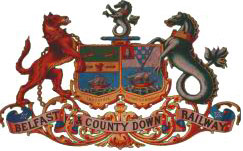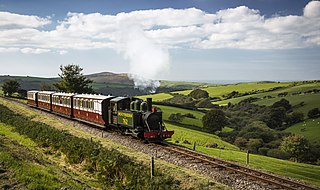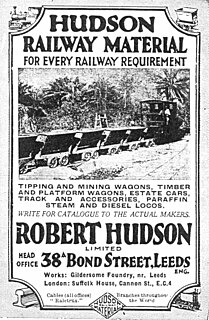
Studebaker was an American wagon and automobile manufacturer based in South Bend, Indiana. Founded in 1852 and incorporated in 1868 as the Studebaker Brothers Manufacturing Company, the firm was originally a coachbuilder, manufacturing wagons, buggies, carriages and harnesses.

The Ffestiniog Railway is a 1 ft 11+1⁄2 in narrow-gauge heritage railway, located in Gwynedd, Wales. It is a major tourist attraction located mainly within the Snowdonia National Park.

Gebr. Märklin & Cie. GmbH or Märklin is a German toy company. The company was founded in 1859 and is based at Göppingen in Baden-Württemberg. Although it originally specialised in doll house accessories, today it is best known for model railways and technical toys. In some parts of Germany and in Sweden, the company's name is almost synonymous with model railways.
The Leek and Manifold Valley Light Railway (L&MVLR) was a narrow gauge railway in Staffordshire, England that operated between 1904 and 1934. The line mainly carried milk from dairies in the region, acting as a feeder to the 4 ft 8+1⁄2 instandard gauge system. It also provided passenger services to the small villages and beauty spots along its route. The line was built to a 2 ft 6 in narrow gauge and to the light rail standards provided by the Light Railways Act 1896 to reduce construction costs.

The Lancashire and Yorkshire Railway (L&YR) was a major British railway company before the 1923 Grouping. It was incorporated in 1847 from an amalgamation of several existing railways. It was the third-largest railway system based in northern England.

The Belfast and County Down Railway (BCDR) was an Irish gauge railway in Ireland linking Belfast with County Down. It was built in the 19th century and absorbed into the Ulster Transport Authority in 1948. All but the line between Belfast and Bangor was closed in the 1950s, although some of it has been restored near Downpatrick by a heritage line, the Downpatrick and County Down Railway.

The North Eastern Railway (NER) was an English railway company. It was incorporated in 1854 by the combination of several existing railway companies. Later, it was amalgamated with other railways to form the London and North Eastern Railway at the Grouping in 1923. Its main line survives to the present day as part of the East Coast Main Line between London and Edinburgh.

The Mid-Suffolk Light Railway (MSLR) was a standard gauge railway intended to open up an agricultural area of central Suffolk; it took advantage of the reduced construction cost enabled by the Light Railways Act 1896. It was launched with considerable enthusiasm by local interests, and was to build a 50-mile network, but actual share subscription was weak, and the company over-reached its available financial resources. It opened 19 miles of route from Haughley to Laxfield in 1904 to goods traffic only, and income was poor, further worsening the company's financial situation.

The Derwent Valley Light Railway (DVLR) was a privately owned standard-gauge railway in North Yorkshire, England, and was unusual in that it was never nationalised, remaining as a private operation all its life. It ran between Layerthorpe on the outskirts of York to Cliffe Common near Selby. It opened in two stages, in 1912 and 1913, and closed in sections between 1965 and 1981. Between 1977 and 1979, passenger steam trains operated between Layerthorpe and Dunnington — the entire length of track at that time. In 1993 a small section was re-opened as part of the Yorkshire Museum of Farming at Murton.

The Lynton & Barnstaple Railway (L&B) opened as an independent railway in May 1898. It was a single track, 1 ft 11+1⁄2 in narrow gauge railway and was slightly over 19 miles (31 km) long running through the rugged and picturesque area bordering Exmoor in North Devon, England. Although opened after the 1896 Light Railways Act came into force, it was authorised and constructed prior to that act. Therefore, as with all other railways, it was authorised under its own Act of Parliament and built to higher standards than similar railways of the time. In the United Kingdom it was notable as being the only narrow gauge line required to use main-line standard signalling. For a short period the line earned a modest return for shareholders, but for most of its life the L&B made a loss. In 1923 the L&B was taken over by the Southern Railway, and eventually closed in September 1935.

The London and North Eastern Railway LNER Gresley Classes A1 and A3 locomotives represented two distinct stages in the history of the British 4-6-2 "Pacific" steam locomotives designed by Nigel Gresley. They were designed for main line passenger services and later express passenger services, initially on the Great Northern Railway (GNR), a constituent company of the London and North Eastern Railway after the amalgamation of 1923, for which they became a standard design. The change in class designation to A3 reflected the fitting to the same chassis of a higher pressure boiler with a greater superheating surface and a small reduction in cylinder diameter, leading to an increase in locomotive weight. Eventually all of the A1 locomotives were rebuilt, most to A3 specifications, but no. 4470 was completely rebuilt as Class A1/1.

The Middleton Railway is the world's oldest continuously working railway, situated in the English city of Leeds. It was founded in 1758 and is now a heritage railway, run by volunteers from The Middleton Railway Trust Ltd. since 1960.

Bingley railway station is a grade II listed railway station that serves the town of Bingley in West Yorkshire, England, and is 13.5 miles (21.7 km) away from Leeds and 5.5 miles (8.9 km) away from Bradford Forster Square on the Airedale line operated by Northern Trains.

Horton-in-Ribblesdale is a railway station on the Settle and Carlisle Line, which runs between Carlisle and Leeds via Settle. The station, situated 47+1⁄4 miles (76 km) north-west of Leeds, serves the village of Horton-in-Ribblesdale, Craven in North Yorkshire. It is owned by Network Rail and managed by Northern Trains.

Cravens Railway Carriage and Wagon Company Limited was a railway rolling stock builder in the Darnall district of Sheffield, England. Founded by brothers named Craven and known as Craven Brothers, later Cravens Limited, it remained a family business until John Brown & Company acquired a controlling shareholding in 1919. Its name was changed back to Cravens Limited in 1954 when it finally became a wholly owned subsidiary of John Brown.

The Wisbech and Upwell Tramway was a rural standard gauge tramway in East Anglia. It was built by the Great Eastern Railway between Wisbech, Isle of Ely, Cambridgeshire and Upwell, now in Norfolk to carry agricultural produce. Although called a tramway, in many ways it more closely resembled a conventional railway line, and paved the way for the passing of the Light Railways Act 1896.
The Drewry Car Co was a railway locomotive and railcar manufacturer and sales organisation from 1906 to 1984. At the start and the end of its life it built its own products, for the rest of the time it sold vehicles manufactured by sub-contractors. It was separate from the lorry-builder, Shelvoke and Drewry, but it is believed that James Sidney Drewry was involved with both companies.

Robert Hudson Ltd was a major international supplier of light railway materials, based in Gildersome, near Leeds, England. The name was later changed to Robert Hudson (Raletrux) Ltd.

The Railway Clearing House (RCH) was an organisation set up to manage the allocation of revenue collected by pre-grouping railway companies for the conveyance of passengers and goods over the lines of other companies. It went on to become the major regulatory body overseeing the day-to-day running of railways in Great Britain and setting common standards for railway companies, which ensured their safety and interoperability. The RCH also produced fare structures governing many aspects of rail transport at a national level and set limits on price increases for passenger travel.

The Outeniqua Transport Museum is a railway museum located in George, South Africa.

















